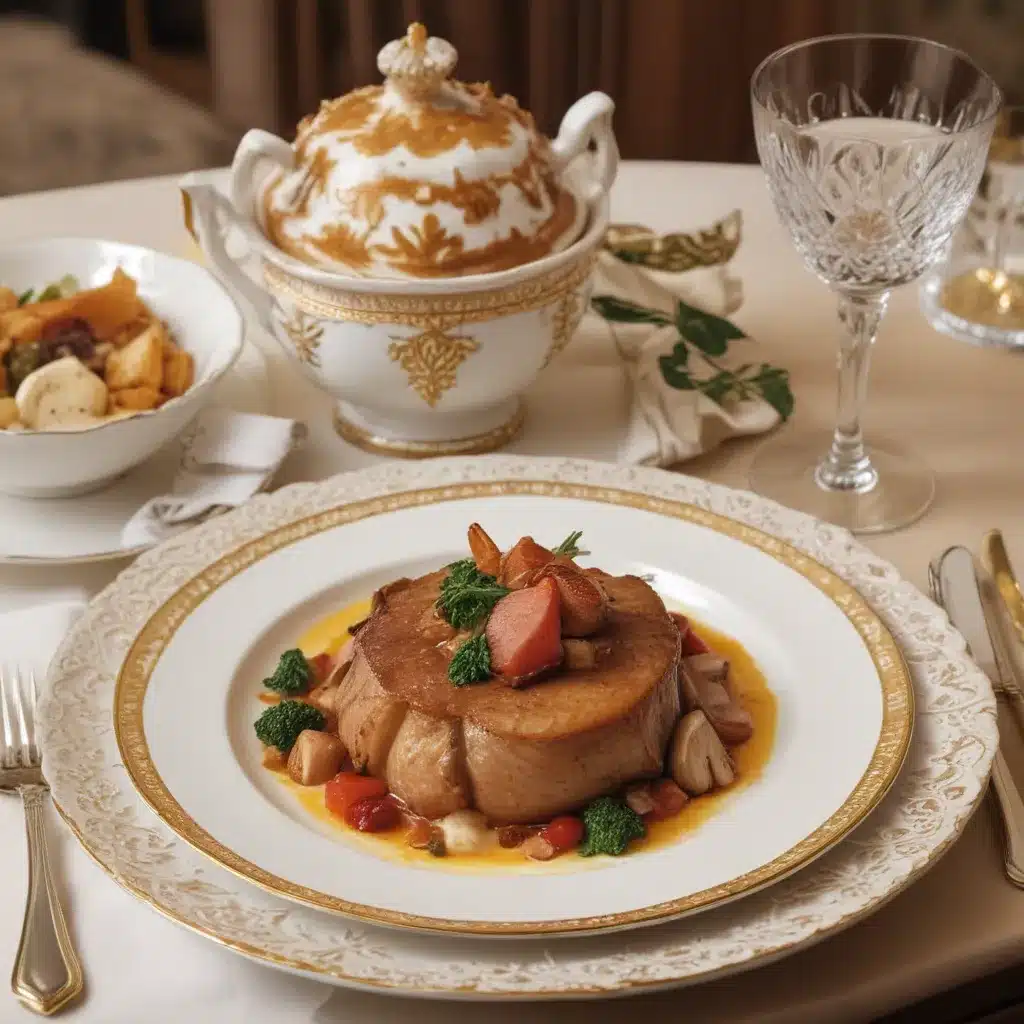
Unveiling the Opulence of the Joseon Dynasty
Step into the grand palaces of the Joseon dynasty and let your senses be swept away by the captivating aromas and elegant presentations of the royal court cuisine. This is a culinary odyssey that transports you back to a time when meals were not merely sustenance, but a dazzling display of power, wealth, and cultural refinement.
As I stroll through the ornate halls of the Joseon royal court, I can almost hear the gentle chimes of bronze ware and the hushed whispers of the palace servants meticulously preparing each course. The kitchens, bustling with activity, are a symphony of chopping, simmering, and the occasional explosive crackle of a sizzling dish. This was the domain of the culinary masters, tasked with nourishing not just the bodies, but the very spirits of the kings and queens.
The diversity of the royal cuisine is truly astounding. Each month, the eight provinces of the Korean peninsula would present their finest regional specialties, allowing the royal chefs to showcase an ever-changing array of flavors, textures, and ingredients [1]. From the briny delicacies of the coastal regions to the earthy, robust dishes of the mountainous areas, the royal table was a veritable tapestry of Korean gastronomy.
Orchestrating the Royal Feast
The preparation of a royal court meal was a meticulously choreographed affair, with each step and presentation imbued with significance. The centerpiece was the surasang, a breathtaking display of three tables laden with an array of dishes, each one a masterpiece in its own right [2].
On the largest round table, the main course reigned supreme – steaming bowls of rice, fragrant soups, and savory stews, alongside an impressive selection of side dishes and fermented delicacies. The smaller round table held the more indulgent offerings, such as the rich and velvety gomtang (beef bone broth) and delicate rice cakes for dessert. And on the rectangular table, a veritable bounty of raw ingredients and sauces awaited, ready to be incorporated into the dining experience.
But the surasang was not merely a feast for the palate; it was a choreographed performance, with the sura sanggung, or palace servant women, serving as the graceful dancers [3]. These women, trained in the art of presentation, would carefully remove the covers from each dish, offering the delicacies to the king and queen with the utmost reverence and precision.
Delving into the Culinary Repertoire
The royal court cuisine of the Joseon dynasty was a symphony of flavors, textures, and techniques, each dish a testament to the ingenuity and skill of the palace chefs. From the delicate rice porridges that graced the breakfast table to the elaborate jeongol (hot pot) simmered over charcoal, every course was a masterclass in balance and harmony.
The savory jjigae (stews) and jjim (braised dishes) were the cornerstones of the royal feast, with each one showcasing a unique blend of ingredients and seasonings. The gamjeong, for instance, was a richly seasoned stew that delighted the palate with its perfect balance of spicy, salty, and umami notes [4]. And the jochi, with its clean, pure flavors, offered a refreshing counterpoint to the more robust dishes.
No royal feast would be complete without the artful displays of raw and pickled delicacies. The saengchae (raw vegetable salads) and namul (seasoned vegetables) were not merely side dishes, but works of art, their vibrant colors and delicate flavors complementing the heartier fare [5]. And the hoe (raw fish) and gui (grilled dishes) added a touch of elegance and sophistication to the proceedings.
Preserving the Legacy of Gungjung Eumsik
In the modern era, the royal court cuisine of the Joseon dynasty, known as gungjung eumsik, has undergone a remarkable revival. Chefs and culinary enthusiasts have dedicated themselves to preserving the techniques, recipes, and traditions that once graced the tables of the kings and queens.
One such institution is the Jihwaja restaurant in Seoul, where the legacy of the royal court cuisine has been meticulously reconstructed and presented to the public [6]. Under the guidance of the Hwang family, who inherited the art of royal cuisine preparation, Jihwaja offers diners a glimpse into the opulent world of the Joseon court, with each course a masterpiece of flavor, presentation, and historical significance.
As I savor each bite, I’m transported to a time when meals were not just about sustenance, but about showcasing the power, wealth, and cultural sophistication of the ruling dynasty. The attention to detail, the harmonious balance of flavors, and the sheer artistry of the dishes are a testament to the enduring legacy of the royal court cuisine.
Feasting Fit for Royalty
In a world where the lines between the past and present often blur, the royal court cuisine of the Joseon dynasty stands as a timeless testament to the culinary prowess and cultural richness of Korea. Whether you’re a seasoned epicure or a curious explorer, a journey through the opulent world of gungjung eumsik is a truly unforgettable experience.
So, let us raise our bowls in a toast to the kings and queens of old, whose discerning palates and unwavering commitment to excellence have inspired generations of culinary enthusiasts. May the legacy of the royal court cuisine continue to delight and captivate, elevating the art of dining to a truly regal experience.
References
[1] Knowledge from https://en.wikipedia.org/wiki/Korean_royal_court_cuisine
[2] Knowledge from https://en.wikipedia.org/wiki/Korean_royal_court_cuisine
[3] Knowledge from https://en.wikipedia.org/wiki/Korean_royal_court_cuisine
[4] Knowledge from https://en.wikipedia.org/wiki/Korean_royal_court_cuisine
[5] Knowledge from https://worldcupoffood.wordpress.com/2014/01/22/polish-cuisine-surowka-raw-vegetable-salad/
[6] Knowledge from https://kimchimari.com/korean-royal-court-cuisine-food-jihwaja-restaurant-seoul/
